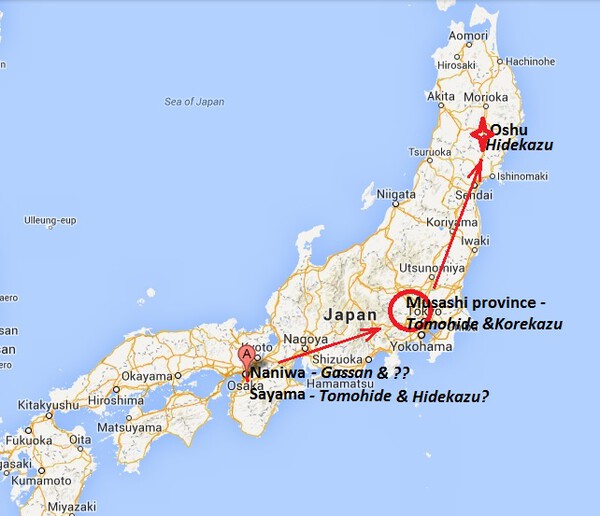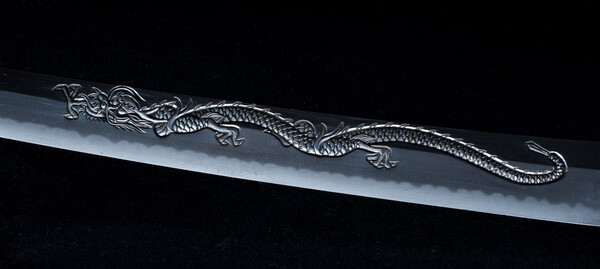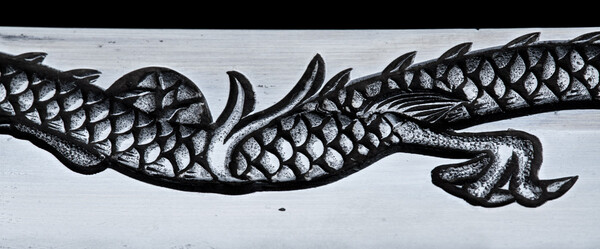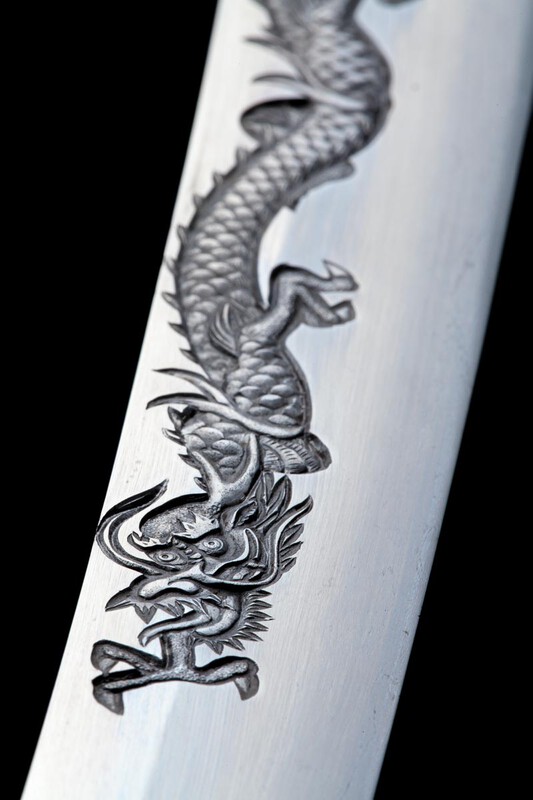-
Posts
34 -
Joined
-
Last visited
Everything posted by Bond
-
Yes probably modern, I found this picture in the internet
-
Guido, regarding that koshirae. Well, I would agree with Matt, taste is often a difficult to agree on subject. Awful... Saya is beautiful, fuchi and menuki are very nice. But yes, there is probably something different in that whole thing. Maybe it would look better with matching kashira? Or shakudo tsuba? Or maybe kozuka would also help? Plus different color ito? Just thinking out loud Woow Doug, what a great story and a wonderful journey! Very inspirational! Thanks so much and I am looking forward to the photos :-) I have read through the links and the whole big thing about the dragons. Interesting, where they are hiding these days... Btw, i found interesting menuki that I believe could match the dragon's theme, unfortunately they are not for sale:
-
Decent fittings - that indeed sounds wise, thanks. I was actually considering modern cast menuki, but you are probably right. And regarding new fittings, the dragon theme seems to be somewhat popular around late Edo what fits the blade and I am more leaning towards the old fittings. Though maybe
-
Alex, right, it is probably better and cheaper to find a sword with koshirae in the first place :-) But I already have a sword and to fully appreciate it I want to feel its weight and its balance, i want to feel menuki and ito tightly wrapped around the tsuka. Just my humble opinion - sword without koshirae is lets say like an engine of antique car but without the body :-) It is very nice, but its just incomplete. Or another parallel can be a samurai sleeping in his night pyjamas vs. the same samurai fully dressed in his armour. If you see what I mean :-) Well, I understand that unfortunately the investment in making a koshirae will by far exceed the end result value. And I can accept that. But would then at least prefer to find more kind of a bargain deal, its no rush now, not like when I was buying a sword :-) Doug, thanks again for your comment and advises, very interesting. I feel that my sword is screaming for koshirae :-) And 38mm opens more options which I am happy about. Do you know approx when your koshirae can be completed? Would be very interesting to see some photos, also of the work-in-progress and the fittings maybe? :-) Regarding the dragons, what is the difference? I have seen so far simplified dragons, then the ones with the scales and without scales. Plus the scaled dragons – males and females, with or without a ken on the tail. Which ones are the sky, water and heaven dragons?
-
Roman, Doug, thank you for the comments. Let me rethink my question. I want to make a traditional koshirae for my sword. And I would like it to be same as if it was originally made for this particular blade. I do not intend to practice with it. Measurements are quite standard: Nagasa: 66,4cm Nakago: 19,7cm Kasane: 7mm Width at machi: 3,2cm Width at yokote: 2cm Kissaki: 3,7cm But I can see only very few fuchi for sale that measure 40mm+. So my question is if 37-38mm is a norm and bigger fuchi is for the wider or more massive blades? I mean from the Japanese point of view? It also would be extremely interesting to see the pictures if anyone had made their koshirae. And I would appreciate any advises if someone has been through this before. It would be nice to avoid at least some mistakes :-) Good point about the koiguchi, it indeed needs to be same as fuchi, thanks Doug. And btw, I would like to buy fuchi&kashira and menuki matching water or clouds or dragon theme. I find combination of black shakudo with gold accents quite appealing, but any offers are welcome :-) Thanks!
-
Gents, what should be the right fuchi size for the katana? Blade is 32 mm. I heard bigger is better, like 4cm length or over. Though my wooden bokken handle measures 37-38mm and feels perfectly fine. Thanks
-

Pics: San Francisco Token Kai
Bond replied to kaigunair's topic in Sword Shows, Events, Community News and Legislation Issues
Guys, where is the "Like" button?!!! -

The Japanese Sword: Video Magazine Edition 2
Bond replied to Paul Martin's topic in General Nihonto Related Discussion
Wow, great work Paul Though I am still struggling to believe my eyes. For me personally it is difficult to associate Nihonto with anime. But well, it is Japanese culture - it’s their game and so they make the rules… -
Stephen, that was not me, but I have an identical one. And I think it's simple pattern is nice. Brian, I found few similar signatures on the forum, thanks
-
Guys, could you please assist with translation of the mei on this tsuba? Thanks!
-
Hello Hoanh! First of all I would like to say again that you did a really good job And if you want to push it even farther - you can do it with some simple improvements. As Uwe and Gabriel said, ISO is an easy fix. Its only 3 steps up from ISO800 to 100, and to compensate the decreased amount of light you simply increase your exposure time with the same 3 steps - for example, from 1/30 to 1/4 or from 1/50 to 1/8. As I said, you have no vibration and changing to ISO100 is a low hanging fruit - it will give you visible improvement at no cost. Gabriel very well commented on your selected apertures. I would only add that as you are using a constant light, you can also use aperture priority mode instead of fully manual mode. You would set the desired aperture & ISO and your camera will select a corresponding shutter speed for the right exposure. Then based on the result you can also adjust it up or down with the exposure compensation. Plus Uwe added a very good comment regarding the RAW converter. Shooting in RAW will give you a huge room for correcting white balance (light temperature), exposure, shadows/highlights etc. DPP that comes free with you camera is a very simple and handy programme. Otherwise Adobe Bridge has even more possibilities to produce from your raw images the result that is closer to what you see with your eyes. Regarding removing background in Photoshop, here is the link: http://www.youtube.com/results?search_query=photoshop+how+to+remove+background check few tutorials and select whichever way seems easier to you. And finally you asked about the lens. In my opinion 60mm macro is a good value for your described needs (and for the money). I would recommend you to use it even for the photos of sugata - it will have less distortions than 18-55. You will need some distance, though I understand you have enough space. Or maybe you would like to look at some lightning sets - flashes/softboxes? Or maybe a scanner is what you need? Could you please post few examples of the pictures that you would like to make? Cheers!
-
Nice photos and a nice blade Hoanh. What was the ISO? You have no vibration, its better to use 100 to avoid noise and to have clearer images
-
Hello Gents! I found this old thread with above mentioned article about scanning nihonto - it is very useful! And I thought to share my learnings, it might be interesting for the ones who would be starting, so they could avoid my mistakes :-) - First it would be much more convenient and faster to scan on a bigger than A4 scanner. - Second, it is better to have a lid that can either be removed or that opens by the long side of the scanner, like the one in the article. - Then having a firm, long and importantly not moving guide(s), alongside which you will be pushing the blade, will save you a good deal of time when you will be stitching images together later. - And also keeping the same scanned area & exposure will serve exactly the same purpose. Avoid changing it - make one preview, set area that will work for all parts of the blade and set the settings. Then just keep scanning and pushing the blade alongside your guide. - Try different scanning directions to find which one works best. Results will be different depending from which direction scanning head moves to the subject. For example I had mune gone in dark on the one side of the blade until I turned the blade upside down. And if you would like to see the results of my new experiment, its here: https://www.dropbox.com/s/2bq5yys8x1hzjy4/pano.jpg As Dropbox'es preview eats all the details - click "Download" in the right top corner to see the actual file, its small just 350kb. Cheers!
-
Alex, thanks and believe me - I was super carefull :-) I used a microfiber and a spirit for the cleaning John, thanks for your comment, and that is the reason why I am searching for the information. Regarding Seiryushi, if I correctly understand this is some kind of additional and made up name, so called gō. Smiths used to change it sometimes. I can see Hawley's translations/explanations of different gō, but how they used to come up with these names? Why for example its a golden dragon son or a heavenly kings something? What is the logic or a story behind? In my case, could it also be that the horimono was curved because of such gō? Bob, thanks :-) And I am not using and not planning to use it for Iaido. Iaido came as a big and free bonus to my new hobby of enjoying nihonto :-) Btw, if I am not mistaken, Japanese have a separate word for it (enjoying nihonto) and also for enjoying the moon - very nice!
-
Ladies and Gentlemen! I have been digging into the meaning of the mei and the story of the blade and I am stuck now at the following: Mei: 浪華住 月山青龍子秀一 浪華住 - Naniwa (Osaka) 月山 - Gassan 青龍子 - “blue dragon son” (why? is it related to horimono?) 秀一 - Hidekazu (smith) Dated to second year of Bunkyū - 1862. Measurements: Nagasa: 66,4cm Nakago: 19,7cm Kasane: 7mm Width at machi: 3,2cm Width at yokote: 2cm Kissaki: 3,7cm From what I have found (please correct me if I am wrong), the shape is standard for the period. According to Hawley’s “Temper lines in Japanese swords”, similar ko-chioji hamon and round boshi was found on both Korekazu (Ishido school) and Tomohide swords. In general sword is from the late EDO when (again, correct me if I am wrong) many smith worked by themselves without following a particular school and copying old Koto swords or whatever they liked to copy. And my katana was papered by Juho Token Kenkyukai, attributed to Hidekazu. Regarding Hidekazu, according to Markus Sesko, he studied first under Tomohide and then also under Korekazu. He was active during Keio, worked in Oshu and died in 1887. Then, Tomohide first worked in Sayama, eastern part of Osaka, which if I correctly understand is about 25 km from Naniwa - more central Osaka. Later during Meiji he moved to Musashi province, where also worked Korekazu - pls see the map: So I would guess that Hidekazu first worked with Tomohide in Osaka somewhere around 1840th-1860th(?). At the same time Gassan worked in Osaka and it is known that he was the teacher of several other swordsmiths. And my sword was made in Osaka, plus it has Gassan’s kanji on it. The question is why? Maybe Hidekazu was also among Gassan’s students? Or maybe Gassan taught Hidekazu to curve the horimono? Or maybe kanji should be read somehow differently? I am most grateful for any clues, references or other help shedding some light on this
-
Hi Sebastien! I should always use "in my opinion" or "I think" :-) And I thought so because habaki is now about 5mm above the top of the file marks line, plus there is an old filled mekugi hole in the shirasaya about 8 mm from the new one
-
I am summarising all the bits and pieces of the information that I have and also some of the questions that I would like to ask - will be posting it soon. Hope you guys can help me finding the answers
-
Thanks for your interest Darcy, I think I know what you mean. I took those photos the very first day as I brought the sword. Later I found some kind of stuff under the habaki also few smaller spots on the mune. It looked like old dried oil or grease. I took liberty and successfully cleaned it, please see new nakago scans attached: It is machi-okuri, about one centimetre or a bit less.
-
Alex & Shizuo, thank you guys :-) Shizuo, it would be great if you could share anything that can help me understanding it. Many thanks in advance!
-
Hello guys, I was playing with the lights and would like to share some horimono pictures with you. It is difficult to capture the volume, depth and the very fine details of the carving. And I still feel that the photos do not do it the right justice. I used to work with metals earlier - it is really amazing how the master curved this on a hard steel with hand tools.
-
Thank you Ken! It is an exciting new learning :-) And regarding the school, I need to check with my sensei, I will PM you :-) Aleksandr







